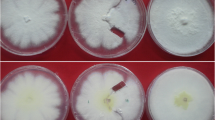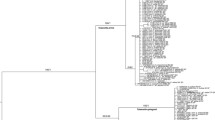Abstract
Mating type allele distribution and phenotypic variability were investigated in field populations of Laccaria bicolor. Sporophores associated with Norway spruce (Picea abies), colonized by natural sources of inoculum and growing in a seed orchard, were sampled to obtain dikaryotic strains and assay their phenotypic variability for traits important to the symbiosis. Basid-iospores were also collected for mating type analysis of different mycelia. Four sporophore mating types were identified containing seven A and five B factors. Out-breeding efficiency was estimated at 73.8% and the population was slightly inbred. Crosses with previously characterized L. bicolor strains from two nearby populations identified in total six sporophore mating types and ten A and nine B factors, for an estimated outbreeding efficiency (85.7%) similar to previous studies of more spatially disparate Laccaria spp. populations. Dikaryotic strains were tested for mycelial growth rate, as a measure of their competitive ability, on agar media containing a soluble (NaH2PO4), or an insoluble (CaHPO4) phosphate source. Their ability to solubilize the latter was also tested to assess their relative capacity to access insoluble, inorganic phosphate. In most cases, significant variation was detected among strains from the same site for all variables. On three sites (VC4, VC5 and VC7), each determined previously to possess a uniform mycelial genotype, phenotypic variability was likely due to epigenetic variation among different strains of the same genotype. Possible evidence for dikaryon-monokaryon crosses was observed in vivo on one sample site (VC2) where adjacent mycelia shared two mating factors. The phenotypic variability of different mycelial genotypes reflected their genetic variability observed as mating type allele diversity and underlined the importance of basidiospore dispersal in introducing new genotypes into the population. The reproductive strategies of L. bicolor are discussed and compared to those of other basidiomycete species.
Similar content being viewed by others
References
Agerer R (1991) Ectomycorrhizae of Sarcodon imbricatus on Norway spruce and their chlamydospores. Mycorrhiza 1:21–30
Baar J, Ozinga WA, Kuyper TW (1994) Spatial distribution of Laccaria bicolor genets reflected by sporocarps after removal of litter and humus layers in a Pinus sylvestris forest. Mycol Res 98:726–728
Bartlett EM, Lewis DH (1973) Surface phosphatase activity of mycorrhizal roots of beech. Soil Biol Biochem 5:249–257
Bastide PY de la, Kropp BR, Piché Y (1994) Spatial distribution and temporal persistence of discrete genotypes of the ectomycprrhizal fungus Laccaria bicolor (Maire) Orton. New Phytol 127:547–556
Binkley D (1986) Forest nutrition management. Wiley, New York
Boidin J (1986) Intercompatibility and the species concept in the saprobic Basidiomycotina. Mycotaxon 26:319–336
Brady NC (1974) The nature and properties of soils, 8th edn. MacMillan, New York
Brasier CM (1987) The dynamics of fungal speciation. In: Rayner ADM, Brasier CM, Moore D (eds) Evolutionary biology of the fungi. (Symposium of the British Mycological Society, University of Bristol, April 1986) Cambridge University Press, Cambridge, UK, pp 231–260
Buller AHR (1958) The effect of diploid on haploid mycelia in Coprinus lagopus, and the biological significance of conjugate nuclei in the Hymenomycetes and other higher fungi. (Researches on fungi, vol IV) Hafner, New York, pp 187–293
Burnett JH (1975) Mycogenetics. Wiley, London
Carlile MJ (1987) Genetic exchange and gene flow: their promotion and prevention. In: Rayner ADM, Brasier CM, Moore D (eds) Evolutionary biology of the fungi. (Symposium of the British Mycological Society, University of Bristol, April 1986) Cambridge University Press, Cambridge, UK, pp 203–214
Caten CE (1987) The genetic integration of fungal life styles. In: Rayner ADM, Brasier CM, Moore D (eds) Evolutionary biology of the fungi. (Symposium of the British Mycological Society, University of Bristol, April 1986) Cambridge University Press, Cambridge, UK, pp 215–229
Chase TE, Ullrich RC (1990a) Genetic basis of biological species in Heterobasidium annosum: Mendelian determinants. Mycologia 82:67–72
Chase TE, Ullrich RC (1990b) Five genes determining intersterility in Heterobasidium annosum. Mycologia 82:73–81
Cromack K Jr, Sollins P, Graustein WC, Speidel K, Todd AW, Spycher G, Li CY, Todd RL (1979) Calcium oxalate accumulation and soil weathering in mats of the hypogeous fungus Hysterangium crassum. Soil Biol Biochem 11:463–468
Dahlberg A, Stenlid J (1990) Population structure and dynamics in Suillus bovinus as indicated by spatial distribution of fungal clones. New Phytol 115:487–493
Deacon JW, Fleming LV (1992) Interactions of ectomycorrhizal fungi. In: Allen MF (ed) Mycorrhizal functioning: an integrative plant-fungal process. Routledge, Chapman and Hall, New York, pp 249–300
Doudrick RL, Anderson NA (1989) Incompatibility factors and mating competence of two Laccaria spp. (Agaricales) associated with black spruce in northern Minnesota. Phytopathology 79:694–700
Doudrick RL, Furnier GR, Anderson NA (1990) The number and distribution of incompatibility alleles in Laccaria laccata var. muelleri (Agaricales). Phytopathology 80:869–872
Dowson CG, Rayner ADM, Boddy L (1989) Spatial dynamics and interactions of the woodland fairy ring fungus, Clitocybe nebularis. New Phytol 111:699–705
Fogel R (1981) Quantification of sporocarp production by hypogeous fungi. In: Wicklow DT, Carroll GC (eds) The fungal community, its organization and role in the ecosystem. Dekker, New York Basel, pp 553–568
Fries N (1983) Spore germination, homing reaction and intersterility groups in Laccaria laccata (Agaricales). Mycologia 75:221–227
Fries N (1987) Somatic incompatibility and field distribution of the ectomycorhizal fungus Suillus luteus (Boletaceae). New Phytol 107:735–739
Fries N, Mueller GM (1984) Incompatibility systems, cultural features and species circumscriptions in the ectomycorrhizal genus Laccaria (Agaricales). Mycologia 76:633–642
Gardes M, Wong KKY, Fortin J-A (1990a) Interactions between monokaryotic and dikaryotic isolates of Laccaria bicolor on roots of Pinus banksiana. Symbiosis 8:233–250
Gardes M, Fortin J-A, Mueller GM, Kropp BR (1990b) Restriction fragment length polymorphisms in the nuclear ribosomal DNA of four Laccaria spp.: L. bicolor, L. laccata, L. proxima and L. amethystina. Phytopathology 80:1312–1317
Gardes M, Mueller GM, Fortin J-A, Kropp BR (1991a) Mitochondrial DNA polymorphisms in four Laccaria species: L. bicolor, L. laccata, L. proxima and L. amethystina. Mycol Res 95:206–216
Gardes M, White TW, Fortin J-A, Bruns TD, Taylor JW (1991b) Identification of indigenous and introduced symbiotic fungi in ectomycorrhizae by amplification of nuclear and mitochondrial ribosomal DNA. Can J Bot 69:180–190
Gates CE, Bilbro JD (1978) Illustration of a cluster analysis method for mean separation. Agron J 70:462–464
Goldstein AH, Liu ST (1987) Molecular cloning and regulation of a mineral phosphate solubilizing gene from Erwinia herbicola. Biotechnology 5:72–74
Hallenberg N (1991) Speciation and distribution in Corticiaceae (Basidiomycetes). Plant Syst Evol 177:93–110
Harley JL, Smith SE (1983) Mycorrhizal symbiosis. Academic Press, London
Ho I (1988) A simple method for assessing acid phosphatase activity of ectomycorrhizal fungi. Trans Br Mycol Soc 91:346–347
Hutchison LJ (1989) Absence of conidia as a morphological character in ectomycorrhizal fungi. Mycologia 81:587–594
Jacobson KM, Miller OK Jr (1994) Postmeiotic mitosis in the basidia of Suillus granulatus: implications for population structure and dispersal biology. Mycologia 86:511–516
Jacobson KM, Miller OK Jr, Turner BJ (1993) Randomly amplified polymorphic DNA markers are superior to somatic incompatibility tests for discriminating genotypes in natural populations of the ectomycorrhizal fungus Suillus granulatus. Proc Natl Acad Sci USA 90:9159–9163
Kay E, Vilgalys R (1992) Spatial distribution and genetic relationships among individuals in a natural population of the oyster mushroom Pleurotus ostreatus. Mycologia 84:173–182
Keller G (1992) Isozymes in isolates of Suillus species from Pinus cembra L. New Phytol 120:351–358
Kroehler CJ, Antibus RK, Linkins AE (1988) The effects of organic and inorganic phosphorus concentration on the acid phosphatase activity of ectomycorrhizal fungi. Can J Bot 66:750–756
Kropp BR (1990a) Variation in acid phosphatase activity among progeny from controlled crosses in the ectomycorrhizal fungus Laccaria bicolor. Can J Bot 68:864–866
Kropp BR (1990b) Variable interactions between non-mycorrhizal and ectomycorrhizal strains of the Basidiomycete Laccaria bicolor. Mycol Res 94:412–415
Kropp BR, Fortin J-A (1988) The incompatibility system and relative ectomycorrhizal performance of monokaryons and reconstituted dikaryons of Laccaria bicolor. Can J Bot 66:289–294
Kropp BR, Langlois C-G (1990) Ectomycorrhizae in reforestation. Can J For Res 20:438–451
Kropp BR, McAfee BJ, Fortin J-A (1987) Variable loss of ectomycorrhizal ability in monokaryotic and dikaryotic cultures of Laccaria bicolor. Can J Bot 65:500–504
Lapeyrie F, Chilvers GA, Behm CA (1987) Oxalic acid synthesis by the mycorrhizal fungus Paxillus involutus. New Phytol 106:139–146
Last FT, Dighton J, Mason PA (1987) Successions of sheathing mycorrhizal fungi. Tree 2:157–161
Mallett KI, Harrison LM (1988) The mating system of the fairy ring fungus Marasmius oreades and the genetic relationship of fairy rings. Can J Bot 66:1111–1116
Marx DH (1969) The influence of ectotrophic mycorrhizal fungi on the resistence of pine roots to pathogenic infections. I. Antagonism of mycorrhizal fungi to root pathogenic fungi and soil bacteria. Phytopathology 59:153–163
Molina R, Massicotte H, Trappe JM (1992) Specificity phenomena in mycorrhizal symbioses: community-ecological consequences and practical implications. In: Allen MF (ed) Mycorrhizal functioning: an integrative plant-fungal process. Routledge, Chapman and Hall, New York, pp 357–423
Mueller GM, Gardes M (1991) Intraand interspecific relations within Laccaria bicolor sensu lato. Mycol Res 95:592–601
Nasmyth K (1983) Molecular analysis of a cell lineage. Nature 302:670–676
Raper JR, Krongelb GS, Baxter MG (1958) The number and distribution of incompatibility factors in Schizophyllum. Am Nat 92:221–232
Rayner ADM (1991) The challenge of the individualistic mycelium. Mycologia 83:48–71
Rayner ADM, Todd NK (1982a) Ecological genetics of Basidiomycete populations in decaying wood. In: Frankland JC, Hedger JN, Swift MJ (eds) Decomposer Basidiomycetes: their biology and ecology. Cambridge University Press, Cambridge, UK, pp 129–142
Rayner ADM, Todd NK (1982b) Population structure in wooddecomposing Basidiomycetes. In: Frankland JC, Hedger JN, Swift MJ (eds) Decomposer Basidiomycetes: their biology and ecology. Cambridge University Press, Cambridge, UK, pp 109–128
Read DJ (1992) The mycorrhizal mycelium. In: Allen MF (ed) Mycorrhizal functioning: an integrative plant-fungal process. Routledge, Chapman and Hall, New York, pp 102–133
Scott AJ, Knott M (1974) A cluster analysis method for grouping means in the analysis of variance. Biometrics 30:507–512
Sen R (1990) Intraspecific variation in two species of Suillus from Scots pine (Pinus sylvestris L.) forests based on somatic incompatibility and isozyme analysis. New Phytol 114:607–616
Smith ML, Bruhn NB, Anderson JB (1992) The fungus Armillaria bulbosa is among the largest and oldest living organisms. Nature 356:428–431
Stenlid J (1985) Population structure of Heterobasidion annosum as determined by somatic incompatibility, sexual incompatibility and isoenzymatic patterns. Can J Bot 63:2268–2273
Stevenson FJ (1986) Cycles of soil carbon, nitrogen, phosphorus, sulphur, micronutrients. Wiley, New York
Ullrich RC, Novotny CP, Specht CA (1985) Nucleic acid studies in Schizophyllum. In: Moore D, Casselton LA, Wood DA, Frankland JC (eds) Developmental biology of the higher fungi. Cambridge University Press, Cambridge, UK, pp 467–484
Villeneuve N, Grandtner MM, Fortin J-A (1989) Frequency and diversity of ectomycorrhizal and saprophytic fungi in the Laurentide mountains of Quebec. Can J Bot 67:2616–2629
Vogt KA, Publicover DA, Vogt DJ (1991) A critique of the role of ectomycorrhizas in forest ecology. Agric Ecosyst Environ 35:171–190
Wong KKY, Piché Y, Montpetit D, Kropp BR (1989) Differences in the colonization of Pinus banksiana roots by sib-monokaryotic and dikaryotic strains of ectomycorrhizal Laccaria bicolor. Can J Bot 67:1717–1726
Zhu H, Higginbotham KO, Dancik BP, Navratil S (1988) Intraspecific genetic variability of isozymes in the ectomycorrhizal fungus Suillus tomentosus. Can J Bot 66:588–594
Author information
Authors and Affiliations
Rights and permissions
About this article
Cite this article
de la Bastide, P.Y., Kropp, B.R. & Piché, Y. Population structure and mycelial phenotypic variability of the ectomycorrhizal basidiomycete Laccaria bicolor (Maire) Orton. Mycorrhiza 5, 371–379 (1995). https://doi.org/10.1007/BF00207409
Issue Date:
DOI: https://doi.org/10.1007/BF00207409




